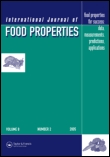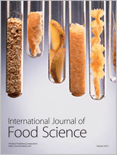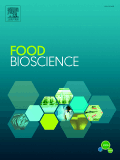
Food Hydrocolloids for Health
Scope & Guideline
Pioneering Discoveries in Hydrocolloid Applications
Introduction
Aims and Scopes
- Food Safety and Preservation:
Research on the use of hydrocolloids to improve food safety and extend shelf life, including studies on antimicrobial properties and packaging innovations. - Nutraceutical Applications:
Exploration of bioactive compounds from food sources and their incorporation into hydrocolloidal systems for health benefits, including antioxidant, anti-inflammatory, and therapeutic effects. - Functional Food Development:
Development of functional foods utilizing hydrocolloids for improved health outcomes, focusing on texture, digestibility, and sensory properties. - Innovative Delivery Systems:
Investigation of novel encapsulation techniques for bioactive compounds, enhancing their bioavailability and controlled release in food and pharmaceutical applications. - Biopolymer Research:
Study of natural biopolymers and their modifications to create new materials with enhanced properties for food applications.
Trending and Emerging
- Edible Films and Coatings:
There is a notable increase in research related to edible films and coatings, particularly those that incorporate active compounds for food preservation and safety. - Microencapsulation Techniques:
Research on microencapsulation has surged, focusing on innovative methods for protecting and delivering bioactive compounds within food systems. - Plant-Based Ingredients:
The trend towards plant-based foods is reflected in the increasing number of studies exploring plant-derived hydrocolloids and their health benefits. - Functional Polysaccharides:
Emerging research on polysaccharides, particularly regarding their functional properties and health implications, is gaining traction, highlighting their role in modern food systems. - Health-Promoting Properties of Food Components:
There is a growing focus on the health-promoting properties of various food components, including their roles in disease prevention and health enhancement, supported by hydrocolloidal applications.
Declining or Waning
- Traditional Food Processing Techniques:
Research on conventional food processing methods has decreased, potentially as newer, more innovative techniques gain traction in the field. - Simple Hydrocolloid Applications:
There seems to be a waning interest in basic applications of hydrocolloids without a health or functional angle, as researchers focus more on complex systems and health-related outcomes. - Generalized Nutritional Studies:
Papers focusing on broad nutritional studies without specific applications of hydrocolloids are less frequent, indicating a shift towards more targeted, application-driven research.
Similar Journals

INTERNATIONAL JOURNAL OF FOOD PROPERTIES
Connecting researchers to the future of food science.INTERNATIONAL JOURNAL OF FOOD PROPERTIES, published by TAYLOR & FRANCIS INC, is a leading platform for disseminating high-quality research in the field of food science. With an ISSN of 1094-2912 and E-ISSN of 1532-2386, this journal has been committed to open access since 2018, ensuring that groundbreaking studies are readily available to global audiences. The journal has steadily gained recognition for its contribution to the discipline, achieving a Q2 ranking in Food Science and placing in the 68th percentile among its peers according to Scopus metrics. Covering a wide array of topics related to the properties and applications of food, it serves as a valuable resource for researchers, professionals, and students alike. With coverage extending from 1998 to 2024, the journal continually seeks to advance knowledge and foster innovation within the food science community, making it a pivotal publication for anyone serious about this vital field.

International Journal of Food Science
Empowering Research in Food Safety and NutritionThe International Journal of Food Science, published by HINDAWI LTD, stands as a crucial platform for advancing knowledge within the realm of food science. Established in 2013, this Open Access journal based in Egypt has garnered significant recognition, achieving an impressive Q2 classification in the 2023 Food Science category, which reflects its commitment to quality and impactful research. With a Scopus rank of #88 out of 389 in Agricultural and Biological Sciences and placing in the 77th percentile, this journal serves as an essential resource for researchers, professionals, and students dedicated to innovative developments and scientific exploration in food science. The journal not only provides unrestricted access to valuable research but also aims to foster collaboration and dissemination of knowledge on critical issues affecting food safety, nutrition, and technology. For those looking to keep abreast of the latest advancements, the International Journal of Food Science is certainly an indispensable addition to their academic pursuits.

Journal of Future Foods
Redefining food systems for tomorrow's world.Welcome to the Journal of Future Foods, a prominent peer-reviewed publication dedicated to advancing knowledge and innovation within the realms of Agricultural and Biological Sciences, Food Science, and Nutrition and Dietetics. Published by KEAI PUBLISHING LTD in China, this journal has rapidly achieved a distinguished reputation, reflected in its impressive Q1 category ranking for both Agricultural and Biological Sciences and Food Science, along with a strong standing in Nutrition and Dietetics. The journal, which spans the period from 2021 to 2025, is committed to fostering interdisciplinary research that addresses the challenges and opportunities presented by the future of food. With a focus on open access, the Journal of Future Foods aims to disseminate crucial findings and foster collaborative dialogue among researchers, professionals, and students alike. By submitting your work, you not only contribute to cutting-edge advancements in the field but also join a vibrant community engaged in redefining the future of food systems.

Current Research in Food Science
Exploring Innovations in Culinary ResearchCurrent Research in Food Science is a leading peer-reviewed academic journal published by Elsevier, specializing in the dynamic field of food science. Since its transition to an Open Access model in 2019, the journal has broadened its reach, contributing significantly to the dissemination of high-quality research. With strong rankings, including a Q1 quartile status in Applied Microbiology and Biotechnology, Biotechnology, and Food Science, it stands out as a pivotal resource for scholars. Based in the Netherlands, current research published within its pages spans a wide range of relevant topics, ensuring that researchers and practitioners stay abreast of the latest advancements. The journal's impressive Scopus rankings enhance its credibility, with a percentile standing in the 74th to 83rd range across relevant categories, underscoring its impact and importance in the academic community. Current Research in Food Science aims to foster the exchange of innovative ideas and foster collaborative efforts among researchers, making it an essential resource for those engaged in advancing the science and technology of food.

Foods is a premier open access journal published by MDPI, based in Switzerland, that has been at the forefront of disseminating high-quality research in the fields of food science, health professions, and plant science since its establishment in 2012. With an impressive convergence of interdisciplinary studies spanning various aspects of food, nutrition, and microbiology, the journal aims to provide a comprehensive platform for researchers and professionals to share innovative ideas and findings. Maintained as a Q1 journal in multiple categories for 2023, including Food Science and Health Professions, Foods has garnered significant recognition within the academic community, reflected in its strong Scopus rankings and percentiles across various disciplines. The journal not only promotes open access to enhance the visibility and accessibility of research but also encourages the exploration of sustainable food systems and health-related issues, thus contributing to essential discussions in today's society. For those looking to advance their understanding and expertise in food-related sciences, Foods serves as an enduring resource for groundbreaking studies and critical insights.

Food Bioscience
Pioneering Research at the Intersection of Food and BiologyFood Bioscience is a leading peer-reviewed journal published by Elsevier, dedicated to advancing the understanding of the complex interplay between food science and biosciences. With an impressive Impact Factor that places it in the Q1 and Q2 quartiles for Food Science and Biochemistry respectively, the journal consistently ranks among the top publications in its field, reflected in its Scopus rankings (Rank #83/389 in Food Science and Rank #175/438 in Biochemistry). Since its inception in 2013, Food Bioscience has fostered a multidisciplinary approach, bridging gaps between research in agricultural, biological, and food sciences, thus encouraging innovative solutions to the pressing challenges facing the global food supply chain. Although it currently operates under a subscription model, the journal is committed to disseminating high-quality research, making significant contributions to both academic scholarship and industry practices. Researchers, professionals, and students alike are invited to explore the wealth of knowledge contained within its pages as it plays a pivotal role in shaping the future of food bioscience.

Food Chemistry-X
Transforming Food Science Through Open Access.Food Chemistry-X is a premier open-access journal published by Elsevier, dedicated to advancing the field of food chemistry through high-quality research and comprehensive reviews. With its ISSN of 2590-1575, the journal has gained significant attention since adopting an open-access model in 2019, allowing wide dissemination of knowledge and innovations in food science. Based in the United Kingdom, it holds prestigious Q1 rankings in both Analytical Chemistry and Food Science categories as of 2023, positioning itself as a leading platform for researchers worldwide. The journal's focus spans extensive topics within food chemistry, including food safety, nutritional analysis, and the chemical properties of food, offering insights that are crucial for addressing contemporary challenges in food production and consumption. With a Scopus rank placing it in the 65th percentile among the top journals in Food Science and the 58th percentile in Analytical Chemistry, Food Chemistry-X is an essential resource for academics, professionals, and students seeking to stay at the forefront of research and innovation in this vibrant field.

FOOD HYDROCOLLOIDS
Unlocking the Secrets of Hydrocolloids for Enhanced Food QualityFOOD HYDROCOLLOIDS is a premier peer-reviewed journal published by Elsevier, focusing on the interdisciplinary field of food science, particularly the role of hydrocolloids in food systems. Established in 1986, this journal has become a leading platform for disseminating innovative research and reviews that advance the understanding of hydrocolloids' chemical and physical properties, their applications in food technology, and their impact on food quality and safety. With a commendable impact factor and consistently ranked in the Q1 quartile across diverse categories—including Chemical Engineering and Food Science—FOOD HYDROCOLLOIDS stands at the forefront of cutting-edge research, evidenced by its top-tier Scopus rankings (8th in Food Science and 8th in General Chemical Engineering). Researchers, professionals, and students are encouraged to explore the wealth of knowledge available through this journal, showcasing advancements and best practices in the use of hydrocolloids for food formulation and processing.

International Food Research Journal
Exploring the Future of Food Technology and NutritionThe International Food Research Journal, published by UNIV PUTRA MALAYSIA PRESS, serves as a pivotal platform for disseminating innovative research within the field of food science. With an ISSN of 1985-4668 and an E-ISSN of 2231-7546, the journal has successfully established its presence since its inception in 2007, converging its findings through 2024. This esteemed journal holds a Q3 ranking in Food Science, illustrating its valuable contributions to the field as demonstrated by its Scopus rank of 276 out of 389, placing it in the 29th percentile among its peers in Agricultural and Biological Sciences. Although it operates under a traditional publishing model, its academic integrity and focus on high-quality research ensure that it remains a vital resource for researchers, professionals, and students eager to explore advances in food technology, nutrition, and safety. By encouraging interdisciplinary collaboration and critical dialogue, the International Food Research Journal plays an essential role in shaping the future of food science research.

Annual Review of Food Science and Technology
Bridging Research and Application in Food ScienceThe Annual Review of Food Science and Technology, published by ANNUAL REVIEWS, is an esteemed journal dedicated to advancing the knowledge within the field of food science. With an impressive Q1 ranking in the Food Science category, and ranking as #6 out of 389 in the Scopus Agricultural and Biological Sciences category, the journal serves as a vital resource for researchers, professionals, and students. This publication encapsulates comprehensive reviews and cutting-edge research, helping to bridge the gap between research and practical application. Though it does not offer Open Access, it provides valuable insights into various aspects of food science from 2010 to 2024, ensuring that its readership stays at the forefront of emerging trends and innovations. The journal's focus on high-quality, peer-reviewed articles makes it a critical platform for scholars looking to deepen their understanding and contribute to this rapidly evolving field.